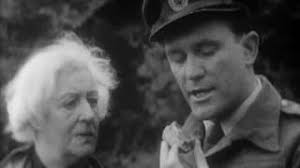
In a farmer’s field something falls out of the sky. It is seen on radar by the Army during a training exercise. The object appears to be a rock of some kind. Believing it to be a meteorite Captain John Dillon (John Stone) takes it to his future father-in-law and meteorite expert, Professor Bernard Quatermass (John Robinson). Quatermass and his associate, Dr. Leo Pugh (Hugh Griffith) examines the pieces and determine that the rock is hollow. Wanting to know more about the rocks, Dillon takes Quatermass to the farmer that found it, Fred Large (Eric Lugg). Fred is feeling under the weather. Mrs. Large (Hilda Barry) says that he began feeling badly the day before after finding the rock. Mr. Large will not discuss the rock.
Quatermass and Dillon leave but stop at a near-by pub. One of the guys in the pub tells them about some strange buildings that are where a village used to be. They ride out to the area and find a large, government run, production plant that looks a lot like the diagram Quatermass designed for his project to create a domed civilization on the moon. As they try to get closer another rock falls from the sky. They find the rock. The gates of the plant open and men rush toward them. As Dillon bends over it the rock cracks open and gas escapes. Dillon inhales the gas, and something happens to his face.
Quatermass II is a six-episode science fiction series produced by the BBC and released in 1955. The series was created by Nigel Kneale. It is the second series done. Only two episodes of the first series are known to still exist. There were four serials all together, “The Quatermass Experiment” 1953, “Quatermass II” 1955, “Quatermass and the Pit” 1958-1`959, and “Quatermass” 1979. There was also a remake of the 1953 series “The Quatermass Experiment” done in 2005. There were four movies done based on the four series.
Several episodes were preceded by a warning that the BBC considered it "unsuitable for children, or people with a nervous disposition."
Writer Nigel Kneale could not think of a dramatic title for the story, so he simply named it "Quatermass II" and justified it to himself by giving the same name to the nuclear-powered rocket which features centrally in the story.

